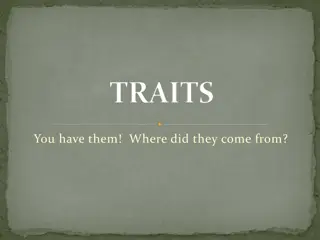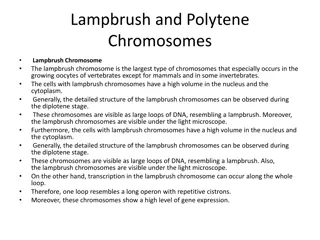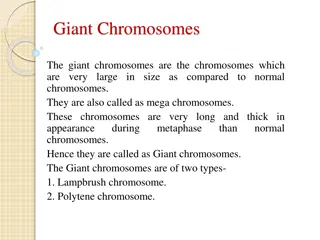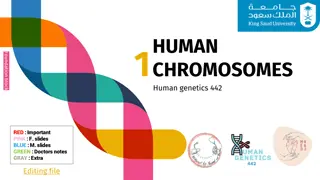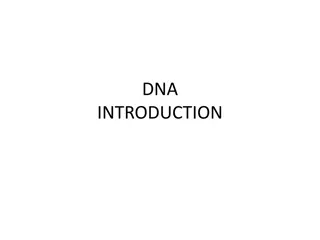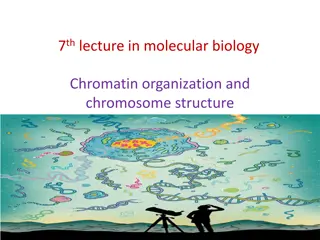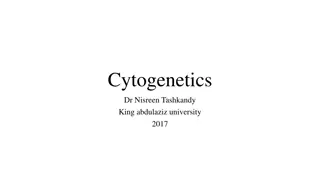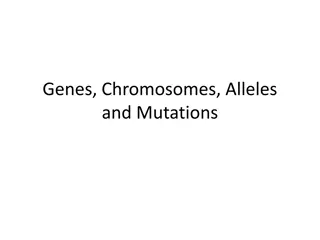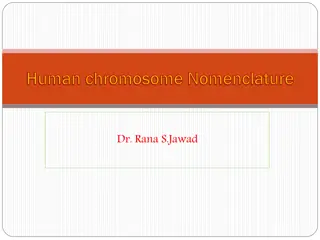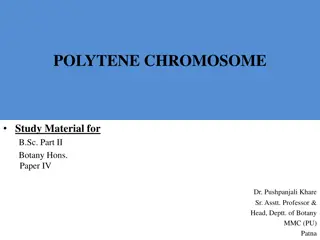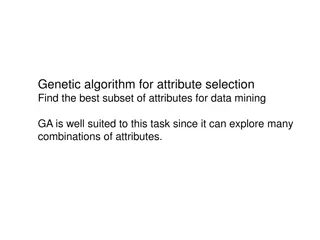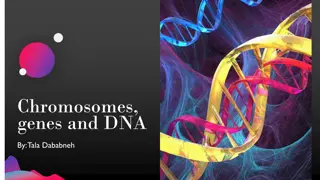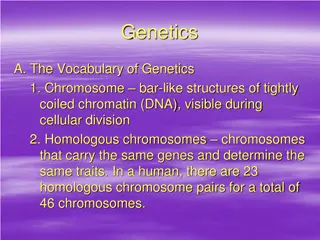Understanding Chromosomes: Key Components, Functions, and Significance
Chromosomes, essential in mitosis and meiosis, are condensed forms of DNA vital for heredity, mutation, and evolution. Learn about their structure, role in inheritance, and impact on species development through historical discoveries. Discover the importance of chromosome sets and genomes in gametic and somatic cells, and the significance of chromosome number in taxonomy and phylogeny.
Download Presentation

Please find below an Image/Link to download the presentation.
The content on the website is provided AS IS for your information and personal use only. It may not be sold, licensed, or shared on other websites without obtaining consent from the author. Download presentation by click this link. If you encounter any issues during the download, it is possible that the publisher has removed the file from their server.
E N D
Presentation Transcript
Ananda Kumar Saha Department of Zoology University of Rajshahi
Chromosome (Gr. Chroma, Colour; soma, body) are the component of the during mitosis and meiosis. most cell, Significant particularly They are capable of self reproduction and play a vital role in heredity, mutation, variation and evolution any development of the species.
Chromosome is the highly condensed form of DNA Wrapped into nucleosomes Wrapped into chromatin
W. Flemming (1879): Described the splitting of Chromosomes and Coined the term Chromatin for sustainable material of the nucleus. W. Chromosome in the mechanism of inheritance. Roux (1883): Involvement of the Benden Chromosomes for each species was constant. and Bovery (1887) : Number of
W. Waldeyer (1888): The present name chromosome was coined byWaldeyer. W.S. Chromosomes messengers of heredity. Sutton and T. Boveri (1902). which acted as Morgan(1933): Transmission of heredity.
The number and set of the Chromosomes of the gametic cells such as sperms and ova is known as the gametic, reduced or haploid sets of chromosomes. The chromosomes is also known as the Genome. haploid set of the The somatic or body cells of most organisms contain two haploids set or genomes and are known as the diploid cells. The diploid cells achieve the diploid set of the chromosomes by the union of the haploid male and female gametes in the sexual reproduction.
Number: The number of chromosomes is constant for a particular species. These are of great importance determination of taxonomy of the species. in the and the phylogeny Lowest number of Chromosome: Two (Ascaris megalocephalus univalens)
The size of the chromosomes varies from species to species and relatively constant for a particular species. Length: 0.2----50 Diameter: 0.2----20 Human Chromosome 6 in length
Chromosome Types There are four types of chromosomes: 1. Telocentric 2. Acrocentric 3. Submetacentric 4. Metacentric Divided based on the position of the centromere
1.Telocentric : no p arm; centromere is on end 2.Acrocentric : very small p arm; centromere is very near end 3.Submetacentric : p arm just a little smaller than q arm; centromere in middle 4.Metacentric : p and q arms are exactly the same length; centromere in exact middle of chromosome
The characters by which a set of the chromosomes of a species is identified, are known as their karyotypes. When the karyotypes of a species are represented by a diagram then such diagram is called idiogram.
Chromomeres: The thick or bead like structures of the chromonema are known as the chromomeres. The cytologist have given various interpretations about the chromomeres. Some consider chromeres as condensed nucleoprotein material, while other postulated that the chromeres are regions of the super imposed coils. For long time most geneticists considered these chromsomes as gene, i.e. the unit of heredity.
Constitutive Heterchromtin: Regions that are always heterochomatic, heterochromatin. called Fecultative Heterochromatin: Regions of euchromatin are heterochromatic state. converted to a
Secondary chromosome besides having the primary constriction or the centromere possess secondary constriction at any point of the chromosome. Constriction: The Certain secondary constrictions play a vital role in the formation of the nucleus, therefore, known as nucleolar zone or nuclear organizer.
Telomere: Each extrimity of the chromosomes has a polarity and therefore, it prevents other chromosomal segments to be fused with it. The chromosomal ends are known as the telomeres. Satelite: Sometimes the chromosomes bear round elongated or knob-like appendages known as satellites. The chromosomes with the satelite are designated chromosomes. as the sat
B-Chromosome: Many plants (Maize, etc.) and animals (such as Insects and small mammals), besides having autosomes (A- chromosomes) and possess a special category of chromosomes called B-Chromosomes without obvious genetic function. Sex-chromosomes About 600 species of flowering plants and more than 100 animal species are now known to carry such B-chromosome (Jones, 1975).
B-chromosomes consequences for the organism, as they have deleterious effects because of abnormal nuclear gametophytes plants. In animals, B- chromosomes occur more frequently in females and the basis is non-disjunctions. have negative divisions of the
Holokinetic Chromosome: The chromosmes of most plants and animals have centromere that are situated as one specific position in each chromosomes. In a number of animals, especially in insects of the order Hemiptera, the kinetic activity is distributed over the entire chromosome and such chromosomes are called holokinetic chromosomes (Sybenga, 1972).
Chemically the Chromosomes of most Prokaryotes and Eukaryotes are composed of mainly DNA which may or may not be wrapped in histone proteins. and non-histone The DNA of bacteria, viruses and cellular organelles may have associated with it but this protein is not intimately associated with the nucleic acid. some protein
DNA of the eukaryotic nucleus associates with specific nuclear proteins the histone and non-histone or acidic proteins, to form a stable nucleo protein complex, the chromatin. Besides the proteins a number of enzymes (DNA and RNA polymerase) intimately associated with chromatin.
The Chromosome are the most significant components of the cell. They control most of the cell biological and genetical activities of a species. They contain the genetical material, the DNA which ultimately influences all the biological phenomena at molecular, physiological and gross morphological levels.




